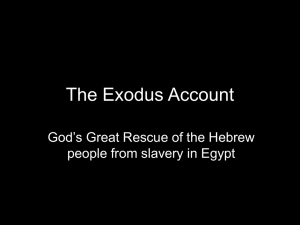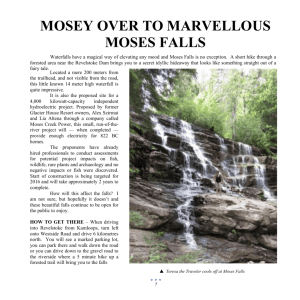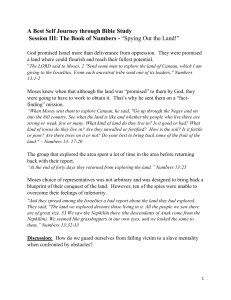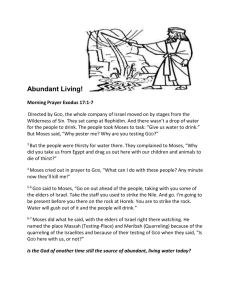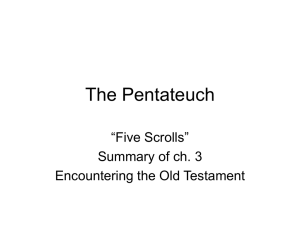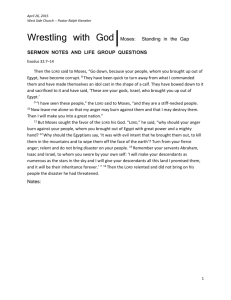Content of the book of Numbers
advertisement
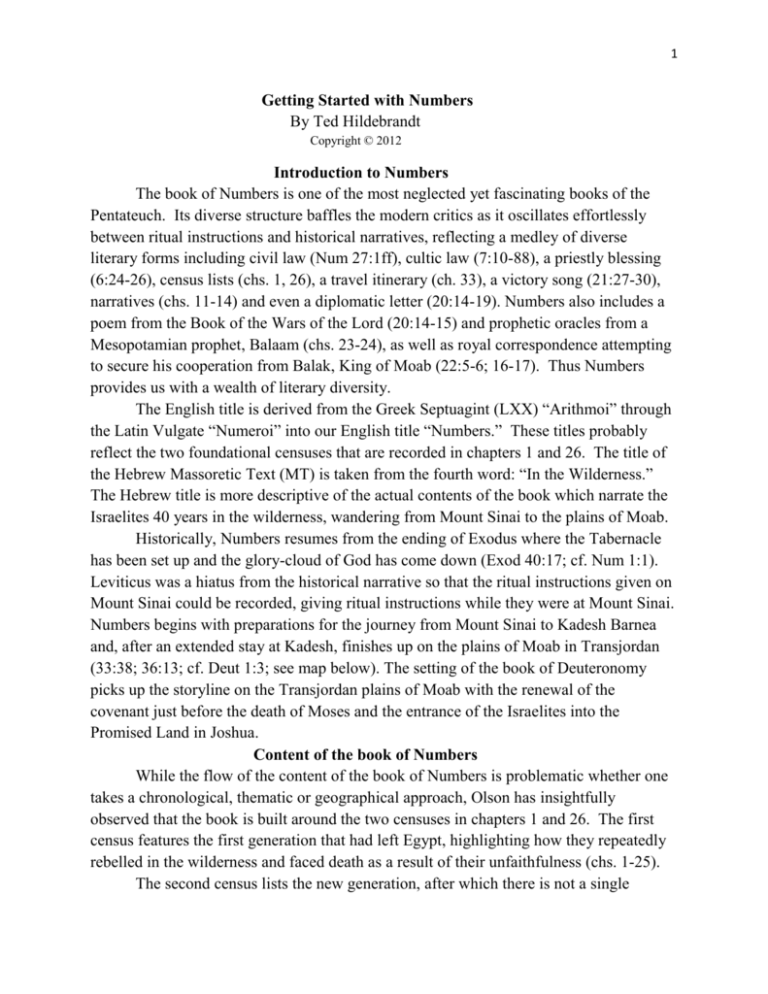
1 Getting Started with Numbers By Ted Hildebrandt Copyright © 2012 Introduction to Numbers The book of Numbers is one of the most neglected yet fascinating books of the Pentateuch. Its diverse structure baffles the modern critics as it oscillates effortlessly between ritual instructions and historical narratives, reflecting a medley of diverse literary forms including civil law (Num 27:1ff), cultic law (7:10-88), a priestly blessing (6:24-26), census lists (chs. 1, 26), a travel itinerary (ch. 33), a victory song (21:27-30), narratives (chs. 11-14) and even a diplomatic letter (20:14-19). Numbers also includes a poem from the Book of the Wars of the Lord (20:14-15) and prophetic oracles from a Mesopotamian prophet, Balaam (chs. 23-24), as well as royal correspondence attempting to secure his cooperation from Balak, King of Moab (22:5-6; 16-17). Thus Numbers provides us with a wealth of literary diversity. The English title is derived from the Greek Septuagint (LXX) “Arithmoi” through the Latin Vulgate “Numeroi” into our English title “Numbers.” These titles probably reflect the two foundational censuses that are recorded in chapters 1 and 26. The title of the Hebrew Massoretic Text (MT) is taken from the fourth word: “In the Wilderness.” The Hebrew title is more descriptive of the actual contents of the book which narrate the Israelites 40 years in the wilderness, wandering from Mount Sinai to the plains of Moab. Historically, Numbers resumes from the ending of Exodus where the Tabernacle has been set up and the glory-cloud of God has come down (Exod 40:17; cf. Num 1:1). Leviticus was a hiatus from the historical narrative so that the ritual instructions given on Mount Sinai could be recorded, giving ritual instructions while they were at Mount Sinai. Numbers begins with preparations for the journey from Mount Sinai to Kadesh Barnea and, after an extended stay at Kadesh, finishes up on the plains of Moab in Transjordan (33:38; 36:13; cf. Deut 1:3; see map below). The setting of the book of Deuteronomy picks up the storyline on the Transjordan plains of Moab with the renewal of the covenant just before the death of Moses and the entrance of the Israelites into the Promised Land in Joshua. Content of the book of Numbers While the flow of the content of the book of Numbers is problematic whether one takes a chronological, thematic or geographical approach, Olson has insightfully observed that the book is built around the two censuses in chapters 1 and 26. The first census features the first generation that had left Egypt, highlighting how they repeatedly rebelled in the wilderness and faced death as a result of their unfaithfulness (chs. 1-25). The second census lists the new generation, after which there is not a single 2 mention of rebellion, unfaithfulness or death as a result of judgment (26:64-65; chs. 2636). Instead, the second generation is filled with hope and a foreword looking perspective that expresses their expectations and plans for settling in the Promised Land. The book opens with the Lord speaking to Moses in the Tent of Meeting at Sinai on the first day of the second month of the second year after coming out of Egypt (1:1). Numbers 7:1 and 9:1, however, describe the setting up and consecrating of the tabernacle which took place a month before the opening verse (1:1) in the first month of the second year. It is apparent that a strict chronological order is not being used to order the events of Numbers. Chapters 1-10 describe the plans for leaving Mount Sinai. Chapter one is the first census of the old, or first, generation that had come out of Egypt and who had received the law at Sinai. Each tribe is listed and every man over twenty counted totaling 603,550, excluding the tribe of Levi which was commissioned to carry the tabernacle and its furnishings. The Levites were chosen in place of Israel’s firstborn (3:12). The camp arrangement is specified in chapter 2 with the tabernacle in the center. Asher Dan Naphtali Levites: Merari--frames Benjamin Levites: Ephraim Gershon-curtains Manassah Tabernacle Priests Issachar Judah Zebulun Levites: Kohath--furniture Gad Reuben Simeon Chapters 3 and 4 describe the duties of the three Levitical clans (Gershon, Kohath and Merari) and what each of their responsibilities were in carrying the furnishings of the tabernacle. The priests were taken from the family of Aaron who was from the tribe of Levi. Purity is featured in chapters 5 and 6 with chapter 5 detailing the ordeal of a wife with a jealous husband and chapter 6 describing the requirements for the Nazirite vow. Samuel and Samson were born as perpetual Nazirites while Paul, in the New Testament, takes a temporary Nazirite vow (Acts 18:18). Chapters 7-8 describe the offerings for the dedication of the tabernacle and the consecration of the Levites. Numbers 9-10:10 concludes this first “old” generation’s preparation for the journey from Sinai with the second Passover and a description of the divine glory-cloud taking the lead as the Israelites begin their journey. Israel embarks on its trek through the wilderness from Mount Sinai to Kadesh Barnea after being instructed on the ordering of the tribes for the journey (ch. 10). In chapters 11-21 there are a series of incidents demonstrating Israel’s unfaithfulness to the Lord in spite of his miraculous provisions in the wilderness. 3 Reference/Name Problem 11:1-2 Taberah 11:4-34 Kibroth Hattaavah Complaining about hardships No meat, only manna 12:1-16 Hazerorth 13:1-14:44 Kadesh Barnea 16:1-17:12 Korah rebellion 20:1-13 Kadesh Barnea 21:4-9 Mount Hor Divine Response Fire burns Moses Intercedes Result Prays Fire dies down Plague –after eating the meat Moses laments burden too heavy Miriam/Aaron oppose Moses’ wife Spies say can’t conquer giants Miriam gets leprosy—turns white Plans to wipe them out Prays for sister God takes the Spirit on Moses and puts it on 70 elders, sends quail meat in Miriam healed and after 7 days her cleanness is restored Korah (Levite) rebels against priests No water Ground swallows them Intercedes: Egyptians will hear, slow to anger Moses separates them from Israel Speak to rock Moses hits rock People speak against God/Moses Serpents bite Prays and put up serpent on pole Spares nation, nation attacks anyway defeated after attacking -- Hormah Aaron’s rod buds; Aaronide priesthood established among the 12 tribes Moses can’t enter Promised Land People look at snake on pole and live (John 3) In the midst of these rebellion cycles there are a couple of ritual texts for supplementary offerings (ch. 15), tassels for garments (ch. 15), and water of cleansing with the red heifer (ch. 19). It is interesting that the chapter where Moses disobeys by striking the rock instead of speaking to it is the very chapter where the deaths of Miriam and Aaron are recorded (ch. 20). In chapter 21, during the journey to the plains of Moab, the first victories are recorded at Arad and the defeat of Sihon king of the Amorites at Heshbon and Og the king of Bashan, followed by the poem of Heshbon (21:27-30). The Balaam narrative (chs. 22-24) and the lapse with the Midianites (ch. 25) complete this section that highlights the flaws of this old generation (chs. 1-25). Balaam, a prophet from Mesopotamia who knew the Lord, after being exhorted to truly proclaim God’s word by his talking donkey, comes to Balak, king of Moab, to curse/bless Israel. He can only render blessings on them in his four prophetic oracles. He foretells, “A star will come out of Jacob; a scepter will rise out of Israel…” (24:17) which many have taken as a Messianic prophecy. Balaam ultimately betrays his calling and likely instigated the Midianite women seducing the Israelite men to worship their gods. Those who participated are slain at Baal of Peor, and Phineas in particular slays a man and his Midianite mistress, thereby stopping the plague (25:7ff). The second census is in Numbers 26 marking the transition from the old, dying, rebellious generation of the wilderness to the new, faithful generation that would possess the land promised to Abraham. There is an inclusio in this section as the new generation thinks about inheriting the land and discusses the inheritance rights of women with the daughters of Zelophehad in the opening of this section (ch. 27). The section closes with the marriage of the daughters of Zelophehad and the preservation of their inheritance (ch. 4 36). Chapters 28 and 29 describe the daily, Sabbath, and monthly offerings as well as reiterate the annual feasts of Israel. The Transjordan tribes, Reuben, Gad and half of Manasseh want to settle in their land (ch. 32) but Moses orders that they must help take the land of Canaan even though they have received their inheritance already in Transjordan. Chapter 33 gives a travel itinerary. Chapter 34 describes the boundaries of Canaan and chapter 35 identifies the Levitical towns and the six cities of refuge. The Levites were to inherit no tribal territory because the Lord was their inheritance. Difficult issues in Numbers Critical approach to Numbers Many critical scholars see Numbers as being composed largely of the priestly tradition (P: post-exilic, ca. 500 BC) with some narratives of JE mixed in. Milgrom has demonstrated that many of the terms, such as “congregation,” “assembly,” “tribe,” and “chieftan,” died out in usage after the 9th century BC and are not found in post-exilic texts. Thus Numbers must have been written prior to the 9th BC contrary to those pushing a post-exilic P source. Milgrom also notes things such as the square camp around a central tent sanctuary that fits the time of Rameses II (ca. 1200 BC) and not the later period which used a round camp. Likewise the ecstatic prophets (11:25) and use of trumpets for worship and war (10:1-10) fit with an earlier date, corroborating the historical veracity of the Scriptures. Large Numbers in Numbers One of the outstanding problems of Numbers is the difficulty with the large numbers recorded in the censuses. The totals are given as 603,550 in 1:46 and 601,730 in 26:51. These numbers are confirmed in counts recorded in Exodus 12:37; 38:26 and illustrate the fulfillment of the Abrahamic covenant of many descendants. The problems in the scribal transmission of numbers is well known. For example, the missing numbers in the age and length of the reign of Saul (1 Sam 13:1) and in comparing the 700 chariots in 2 Samuel 10:18 and the 7,000 in 1 Chronicles 19:18. Yet there are no significant variants in the text of Numbers. Several things call for shrinking these large numbers. Why would an army of over half a million fear taking a small town like Hebron or Jericho with about 10 acres housing under a couple thousand people? How would 2-3 million people survive in the Sinai desert? Would Pharaoh’s 600 chariots really terrify an army of 600,000? The Levite population replaced the firstborn but that doesn’t fit well with what is known about family sizes (Num 3:42-47). Why is there the fear of being too few so that the animals would overrun the land (Exod 23:29; Deut 7:22)? The size of an ancient army of 600,000 is almost unheard of. More typical is the tribe of Dan that goes up to conquer Laish with 600 armed men (Judg 18:11). 5 Several solutions have been proposed: ‘eleph, the word for thousand, really means “clans” (1 Sam 23:23) or “chiefs” (Gen 36:15ff.). Yet this interpretation doesn’t seem to work. Others have proposed a gematria meaning a large number stands for some meaning like how the 375 proverbs in the book of Proverbs is equal to the name Solomon or how 14 in Matthew 1 references David. Again it doesn’t seem to work in Numbers. Saying it is simply hyperbolic language also doesn’t deal with the specifics of the situation. Thus it is probably best to realize that we must await a solution to this problem. Theology God It is amazing to watch God’s dynamic interaction with his people in the book of Numbers. God gets angry (11:1, 33) and the people are punished with fire, snakes and the ground swallowing them down. What is so fascinating is to watch God change his mind as a result of Moses’ intercessory prayer. In Numbers 14:12 after the refusal to go up and take the Promised Land, God proclaims, “I will strike them down with a plague and destroy them….” Moses prays and God responds, “I have forgiven them, as you asked” (14:20). This is no mere anthropomorphism or testing of Moses, rather this reflects a God who is responsive to the prayer of his servant Moses. Surely his character and promises are unchangeable (23:19), yet in the rough and tumble of life in the desert God is engaged and interactive not static, distant and locked into his own predeterminations regardless of what humans do. The book of Numbers declares God’s faithfulness in the face of Israel’s continued rebellion and unfaithfulness. God’s presence (9:15ff) is a blessing (6:24-27) that demands purity and it is something that must be reckoned with. Moses The character of Moses as an intercessor for the nation is huge in the book of Numbers (11:2; 14:13, 20; 21:7). His humility was well noted (12:3). He graciously desired to democratize the gifts of the Spirit (11:29) rather than clutching onto them in an attempt to maintain power. His relationship with God is contrasted to the normal prophets to whom God spoke through dreams and visions but with Moses he spoke “face to face” (12:8). Yet even Moses due to his unbelief faced a disappointing death (20:12). There is much in this book that is relevant to leadership and the struggles leaders face (Num 11:11ff.; 12:2; 16:3ff). People of God One is amazed at how fickle, rebellious and unfaithful Israel is portrayed in Numbers contrary to the fact that they had seen God’s repeated miracles at the sea, with 6 the manna and with the provision of water in the desert. Seeing miracles and God’s activity does not always guarantee belief. Furthermore, what other self-reporting ancient document portrays their forefathers in such a realistic manner? Even Moses is seen struggling (ch. 11) and faltering (ch. 20). This again confirms the historical realism of Scripture. Land As there are two generations, so there are two lands contrasted in Numbers. The wilderness is full of trials, chaos, struggles, need, disorientation, and death while the Promised Land is full of hope, permanence, promise, abundance, order, and life. Questions to think about 1) How is the ordeal of the woman with the jealous husband to be understood in light of ancient Near Eastern customs (Num 5)? 2) How do you understand Number 12:3 on Moses’ humility and Mosaic authorship? 3) How do you understand God changing his mind at the request of Moses’ intercessory prayer (Num 14:12-21; cf. 23:19)? 4) How is the role of leadership developed in Numbers? 5) What role does Numbers play in the rest of Scripture (1 Cor 10; Heb 3-4; Ps 78; 106)? 6) How do you understand God’s anger and his slaying of Israelites in Num 11:1-2; 16; 21:4ff; 25:1-13)?
